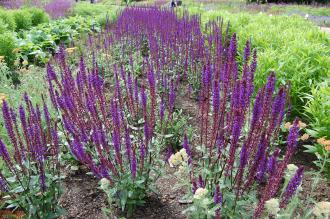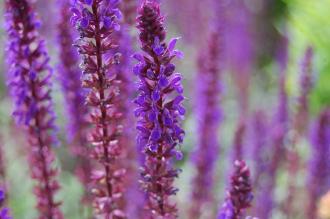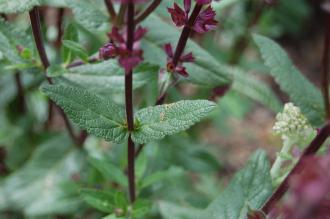
Salvia nemorosa ‘Caradonna’ (02/07/2016, Kew Gardens, London)
Position: Full sun to partial shade shade
Soil: Moist, well drained
Flowering period: Summer to autumn
Eventual Height: 70cm
Eventual Spread: 50cm
Hardiness: 5a, 5b, 6a, 6b, 7a, 7b, 8a, 8b, 9a, 9b
Family: Lamiaceae
Salvia nemorosa ‘Caradonna’ is a semi evergreen herbaceous perennial with a clump forming habit. Its dark green aromatic leaves are narrowly ovate with sinuate margins, rough in texture, up to 8cm ling and 3cm across. Its violet-purple flowers appear as branching racemes.

Salvia nemorosa ‘Caradonna’ Flower (02/07/2016, Kew Gardens, London)
The species, Salvia nemorosa, commonly known as Woodland Sage or Balkan Clary, is native to much of central Europe and west Asia.
The etymological root of the binomial name Salvia is derived from the Latin salvare, meaning to ‘save’ or ‘heal’, in reference to its historical use as a medicinal plant. Nemorosa is derived from the Latin nemus meaning ‘forest’, in reference to its woodland origins.
The Landscape architect may find Salvia nemorosa ‘Caradonna’ useful in herbaceous planting schemes, prairie style planting schemes and wildlife gardens. Once established this plant is drought tollerant and suitable for use in xeriscaping. This plant is is deer resistant.
Ecologically, Salvia nemorosa ‘Caradonna’ flowers will attract pollinating insects, including butterflies and bees.

Salvia nemorosa ‘Caradonna’ Leaf (02/07/2016, Kew Gardens, London)
The Royal Horticultural Society has given Salvia nemorosa ‘Caradonna’ their prestigious Award of Garden Merit in 2012.
Salvia nemorosa ‘Caradonna’ prefers moist, humus rich, well-drained soils. It tolerates most pH of soil.
Salvia nemorosa ‘Caradonna’ requires little maintenance. The flower spikes may be removed as soon as they start to fade to prolong its flowering period.

Landscape Architecture

